
A spork or a foon is a hybrid form of cutlery taking the form of a spoon-like shallow scoop with three or four fork tines. Spork-like utensils, such as the terrapin fork or ice cream fork, have been manufactured since the late 1800s; patents for spork-like designs date back to at least 1874, and the word "spork" was registered as a trademark in the US and the UK decades later. They are used by fast food restaurants, schools, prisons, the military, and backpackers.
The spork is a portmanteau word combining spoon and fork. Similarly, the word foon is a blend of fork and spoon. The word "spork" appeared in the 1909 supplement to the Century Dictionary, where it was described as a trade name and "a 'portmanteau-word' applied to a long, slender spoon having, at the end of the bowl, projections resembling the tines of a fork". -- Wikipedia.
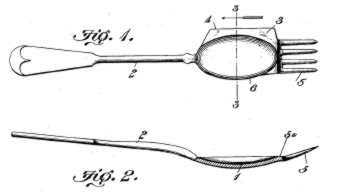
Folks,
My good friend Pete at WRSA suggested some weeks ago that I do a praxis on the mighty Lexan spork, so, after some study and deliberation, here it is.
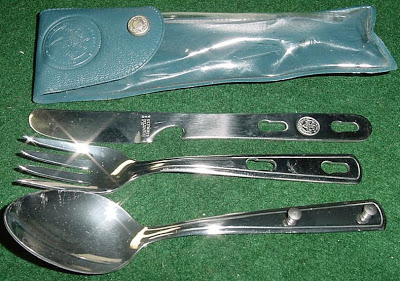
My first camping experiences were, as many folks of my generation may share, part of my Boy Scout membership. There I learned to like the above eating utensil combination of stainless steel. It was heavy, but it being stainless steel you could actually boil it and get it sanitary for your next meal, unlike some of the wooden and early plastic utensils that some Scouts used. Indeed, the first spork I can recall seeing was one made of wood, crafted of some exotic wood, teak perhaps, in a high school shop class by a fellow Scout. But as for the weight, I was young and didn't know any better. This Boy Scout kit is still serviceable today, and in the 90s I spotted many of these at militia FTXs.
(I also learned in my scouting days what a sorry piece of cookware the issue Boy Scout aluminum mess kit was, but that is for another future praxis post.)
Sporks come in two basic designs and a variety of materials, shapes and colors. Here is the spork that anyone who has eaten at Taco Bell will recognize.
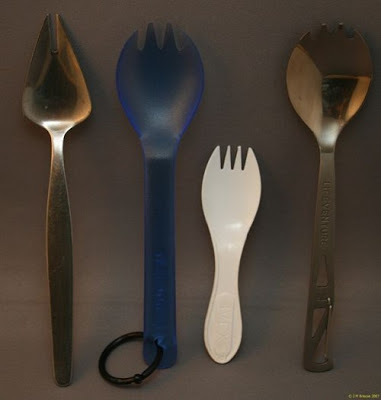 Four versions of the one-ended Spork, in Stainless Steel, Lexan-Plastic,Disposable Plastic, & Titanium. (I particularly like the can opener on the end of the titanium example.)
Four versions of the one-ended Spork, in Stainless Steel, Lexan-Plastic,Disposable Plastic, & Titanium. (I particularly like the can opener on the end of the titanium example.)This is the one-ended spork, with the tines made onto the bowl. Now this is fine, as far as it goes, but if you're like me, you have discovered that trying to eat liquids and other runny stuff, or noodles, is problematic. Ever tried to clean out the last bits of stuff that adheres to the bottom crevices in a cooking pot or canteen cup with a Spork. It is almost as frustrating an experience as my first marriage. Other folks must have thought so too, for the double-ended spork is now almost as ubiquitous as the single-ended and much more popular with hikers and other folks who have to provide for their own "One-Man Logistics" (to borrow a phrase from S.L.A. Marshall's perceptive 1949 study, The Soldier's Load and The Mobility of a Nation, published by the Marine Corps Association Press, Quantico VA, 1980).
Behold, then, the double-ended Lexan Spork (weight approximately 0.3 oz):
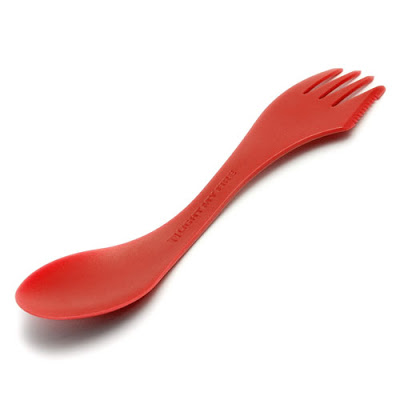
Now, the double-ended Lexan spork is mighty fine, but where it fails is putting the utensil to the test of fire.
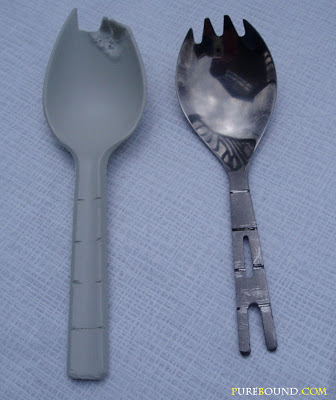
Note the Lexan sample on the left versus a modified titanium one on the right. This was the fate of many an MRE spoon in the 90s when we were doing extensive "armed camping trips." If it is made of plastic, it WILL melt, even if it is of Lexan.
Stainless steel, of course, will not melt, but it is, by the ounce-allergic standards of today, inordinately heavy. And ounces DO count. "Light is right", is my mantra. Thus we come to the Titanium spork, the ne plus ultra of modern camp cutlery.
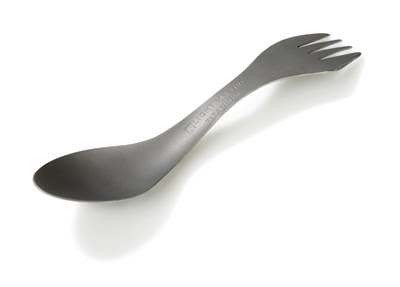
This is my current favorite: the LightMyFire Titanium Spork. At almost twenty bucks it is expensive, true, but being titanium it is well-nigh indestructible and weighs in at a feathery 0.6 ounces (17 grams). It combines a knife, fork and spoon in one design and one review says it should be more properly referred to as a "knifoon."
There are many other titanium sporks available, some for as little as five bucks. PureBound.com, here, shows how a titanium spork can be modified to use as a measuring device for cooking in lieu of a measuring cup. Which, if you're like me and have a tough time estimating water volume for recipes, is a "goodness thing."
Anyway, that is my review of the might spork. Feel free to contribute your own cooking gear ideas and experiences in the comments below.
Mike
III
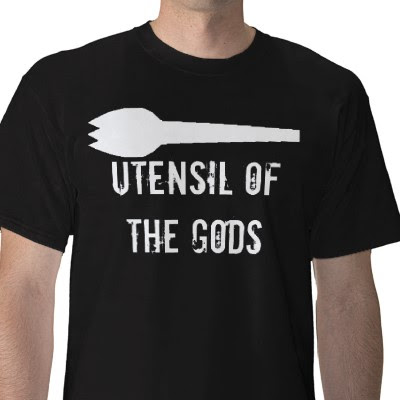
9 comments:
To save weight, learn to use chopsticks. You can cut them from any bush nearby, and discard them after use. Providing you do not use a poison bush, they can be more sanitary, and less trouble.
super-lightweight bicycle people have a phrase for under-weight gear that can ---just-barely--- perform the function under ideal conditions, but will fail completely if the threshold is passed one time: Stupid-Light.
Think of handlebars. Is it better to have the lightest bars made of contoured honeycombed epoxy-aluminum, helium-filled zero-G foamed titanium, or endure an extra 15 grams to use thick aluminum tubing that will survive anything? Bonus for aluminum: $1000 that can be put toward training consumables.
When there is extra money for Ti, lighten up, add function AND get sturdier. We shouldn't forget to use our brains just because throwing cash at the problem improves it (or seems to be an improvement).
NASA does weight management well. There are hard limits to payload with a launch vehicle, as well as trade-offs of speed/distance/mass.
On foot, the same principals apply, with some fudging given by shouting at the pack animals and insisting that they have little sisters who are stronger and faster.
There's a sweet spot for how much money a gram of weight reduction is worth. Early weight reduction is cheaper (organization, planning, caching, trading WWII technology for 1990's camping/hiking technology). The last grams removed might cost hundreds then thousands each.
All non-disposable sporks should have a string attached for retention and dipping into boiling water. I wouldn't drill a hole in the lexan, but a hole in the Ti models won't hurt.
How many more sporks can I carry if I lose 10 pounds of fat (35000 calories)? None. Split added capacity between ammo and canteens.
Cheers.
Oh boy another one!
I used the Light my fire lexan spork for the last couple of years, I am happy with it but it has it's flaws. Number one being that the fork end kinda sucks. Fails as a fork more often than I'd like. And the little "edge" on the side is a joke.
Santa left in my stocking this year a set of Guyot Designs MicroBites:
http://www.guyotdesigns.com/Product-Microbites
I couldn't be happier! It's two things, a spork, and a spatula/knife snapped together. The spork is awesome, it works equally well on soup and a thick steak and everything in between. And the spreader knife thing is a lot more usefull than I expected, it actually CUTS! And it's great for one of my favorite outdoor delicacies, nutella spread on crackers. A trick I found with these, is that I take the little paracord lanyard I put on them, cinch it down, and wedge a little stick at the top in between the two utensils, and I you get very effective tongs. They also make a large version suitible for reaching deep into MRE pouches and freezer bag meals and deep pots and such.
Another one I like is the snowpeak titanium spork:
http://www.tadgear.com/shop.php?id=47
Same basic design as the guyot spork, except it's titanium. They also make a set of spoon fork and knife like your boyscout set in Ti, pretty cool.
-Anonymous Gear-Whore
One of my Boy Scout leaders was a World War II Navy vet, with a PhD in Economics, who preached the virtues of lightweight backpacking before it was fashionable. He taught us to take only a tablespoon to eat with, and I have been doing that for 40 years now. You can spear things with your knife or make a skewer with a piece of wood if necessary, but most foods can be readily eaten with a spoon. I've not used the spork much, and dislike the plastic ones, but I'll have to try a titanium one.
Squid
III
I have been putting my kit together and I have been considering getting a spork of some sort. I think the Ti spork is nice but I think I will err on the cheap side for this one.
Gear-Ho: One BIG problem I see with your linked "magic" set:
"...Every MicroBites set will carry more than 25lbs of verified green house emissions reductions — making MicroBites not just carbon neutral — but carbon negative..."
Really?
I'm afraid that alone's enough for me to boycott it.
WE NEED MORE "Global Warming" - NOT LESS!!
Buggers...
Just remember that a plastic spoon is pretty much required for winter camping (well, here in the Northwoods, at least). The last thing you need when it's -27*F outside is to have a SS utensil stick to you lips and tongue and cause tissue damage and frost bite.
Agreed on the Snowpeak titanium spork. My wife and I have had ours for six years or so, and I use it every day. The hybrid designs with the spoon on one end and the fork and knife on the other end haven't impressed me, although the Ti model you link here has an actual spoon on it! It actually looks like the Asian style "shovel" spoon - I have been known to carry aluminum versions of these in my pack and day bag as well, as they are handy.
Chopsticks, as noted by RLJ, are also excellent for food prep. Laquered wood or hardwood versions are very light-weight and handy.
As PDXr13 notes, there is a significant point of diminishing returns here, particularly financially. I let other people take the pain for me in this regard - I have solidly rounded out kid, and will only spend money when I see a need that isn't met or a significant improvement. In other words, I like to buy gear from ultralight backpackers!
I carry a plain-jane kitchen spoon in my kit. I can quickly make a fork-like implement, but why bother?
God DID give us fingers...
Post a Comment